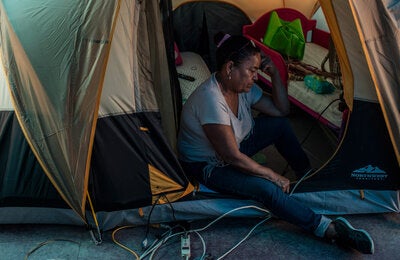

More than 1 billion people in 19 countries are now covered by laws requiring large, graphic health warnings on packages of tobacco, nearly double the number of two years ago, when only about 547 million people were covered in 16 countries, the World Health Organization reports.
7 July 2011 | Geneva | Montevideo, Uruguay - More than 1 billion people in 19 countries are now covered by laws requiring large, graphic health warnings on packages of tobacco, nearly double the number of two years ago, when only about 547 million people were covered in 16 countries, the World Health Organization (WHO) reports today in its third periodic report on the global tobacco epidemic.
Mexico, Peru and the United States of America become the latest countries to require the large, graphic warnings, which are proven to motivate people to stop using tobacco and to reduce the appeal for people who are not yet addicted.
The WHO Report on the Global Tobacco Epidemic, 2011 also examines anti-tobacco mass-media campaigns, finding that more than 1.9 billion people live in the 23 countries that have implemented at least one strong campaign within the last two years.
"We are pleased that more and more people are being adequately warned about the dangers of tobacco use," says WHO Assistant Director-General for Noncommunicable Diseases and Mental Health, Dr Ala Alwan. "At the same time, we can't be satisfied that the majority of countries are doing nothing or not enough. We urge all countries to follow the best-practices for reducing tobacco consumption and to become Parties to, and fully implement, the WHO Framework Convention on Tobacco Control."
Requiring large, graphic health warnings is among the six demand-reduction measures recommended by WHO. The other measures involve monitoring tobacco use; protecting people from tobacco smoke; helping users quit; enforcing bans on tobacco advertising, promotion and sponsorship; and raising taxes on tobacco. Each measure corresponds to at least one provision of the WHO Framework Convention on Tobacco Control, which has been in force since 2005 and to which more than 170 countries and the European Union have already become Parties. The measures are identified as "best" and "good buys" in tobacco control.
Of the world's more than 1 billion tobacco smokers, more than 80% live in low- and middle-income countries and up to half will eventually die of a tobacco-related disease.
This year, the tobacco epidemic will kill nearly 6 million people. More than 5 million of them will be users and ex-users of smoked and smokeless tobacco and more than 600 000 will be nonsmokers who were exposed to tobacco smoke. By 2030, tobacco could kill 8 million people a year. Tobacco use is one of the biggest contributors to the noncommunicable diseases epidemic, which includes heart disease, stroke, cancers and emphysema and accounts for 63% of deaths.
"Large, graphic health warnings of the sort pioneered by Uruguay, Canada and a handful of other countries are an effective means of reducing tobacco's appeal," says the Director of WHO's Tobacco Free Initiative, Dr Douglas Bettcher. "Australia's proposed legislation to require that tobacco be sold in plain packaging will do even more to ensure that fewer people fall into the trap of sickness and premature death. WHO stands ready to help countries resist the tobacco industry's unprincipled attempts to eliminate these important protections."
More than half of the world's population, or 3.8 billion people, is now covered by at least one of the above-mentioned demand-reduction measures. There have been gains in each area because of effective action taken by countries in 2009 and 2010.
Among the other key findings of the report:
- More than 739 million people in 31 countries are now covered by comprehensive laws requiring smoke-free indoor spaces — a more than twofold improvement over the 2009 version of the report, which showed that more than 353 million people were covered in 15 countries. Burkina Faso, Nauru, Pakistan, Peru, Spain and Thailand are among the latest countries to ban smoking in indoor public spaces and the workplace.
- Twelve more countries raised tobacco taxes to more than 75% of the retail price, bringing the total to 27.
- Three more countries — Chad, Colombia and Syria — banned tobacco advertising, promotion and sponsorship.
- One more country — Turkey — offered tobacco users comprehensive help to quit.
Related links:
- WHO Tobacco Free Initiative
- WHO Report on the Global Tobacco Epidemic, 2011
- WHO Framework Convention on Tobacco Control
- MPOWER
- WHO pictorial health warnings database
- Showing the truth, saving lives: the case for pictorial health warnings
- United Nations General Assembly High-Level Meeting on the Prevention and Control of NCDs
For more information, please contact:
Timothy O'Leary, Communications Officer, Tobacco Free Initiative, WHO, Geneva, Telephone: + 41 22 791 5539, Mobile: +41 79 516 5601.
Kerstin Schotte, Technical Officer, Tobacco Free Initiative, WHO, Geneva, Tel: + 41 22 791 3583, Mobile: +41 79 445 2340.
Douglas Bettcher, Director, Tobacco Free Initiative, WHO, Geneva, Telephone: + 41 22 791 4253, Mobile: +41 79 249 3522.
Armando Peruga, Programme Manager, Tobacco Free Initiative, WHO, Geneva, Telephone: + 41 22 791 1496, Mobile: +41 79 249 3504



